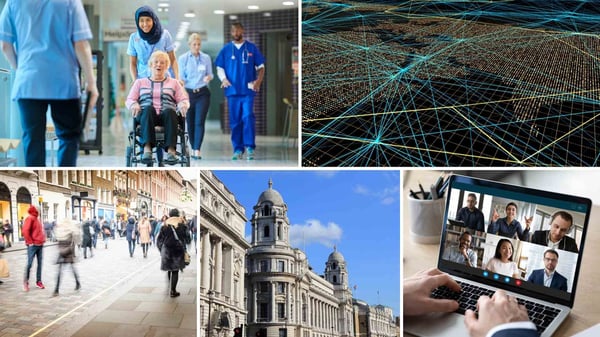The future of digital experience in government
What are some of the key trends in digital experience - and what impact will they have on the design and delivery of citizen services? We spoke with senior civil servants and executives from Adobe, and Government Transformation Magazine’s General Manager David Wilde, to find some answers.
The state of play
As citizen interactions with public services become increasingly digitised, the digital experience has gone from being a competitive advantage to a marker of government competence. Users expect fast, personalised, and anticipatory digital experiences as standard.
Adobe’s 2022 Digital Trends: Public Sector in Focus report, found that only 14% of government and public sector respondents believe their digital experience is ahead of the public’s expectations. To keep up, government organisations need to innovate their digital offering.
“This means thinking about how departments can collaborate more and modernise service delivery so that it becomes more anticipatory and less repetitive and disjointed across channels and settings,” said Manny Vaghela, Senior Director Solution Consulting at Adobe.
The personalised experience
There was a clear appetite among civil service leaders to realign government services with what citizens really want and how best to do this.
“You've got citizens and businesses that want simplicity. It is clear that they want minimal interaction with the government and getting this right will have big implications for the future of public service delivery,” Wilde said.
There was an understanding that digital transformation does not have to be particularly novel, but systems do need to be more modernised. As one civil servant noted: “Digital transformation across government services just needs to be enough that we are not putting citizens and residents off using it.”
There was a particular emphasis on the need to transition to a citizen-centric approach to digital public service delivery, which requires governments to focus their efforts on the customer’s perspective and to continuously measure the success of these strategies.
“The next generation of citizens will simply not put up with a disparate digital system,” said Simon Murray, Practice Lead FSI, Digital Strategy Group at Adobe. “They want one single experience that really wants to be digitally connected to the government services. If you remain in those silos and isolated systems, you will never innovate and you will never connect with your citizens.”
Platforms like Amazon and Netflix have set the baseline for how people interact with technology, and with these citizen expectations growing every year, there is pressure for the government to start thinking bigger.
“Rather than doing small, incremental changes like taking paper-based processes and digitising them exactly as they were offline, digital transformation needs to be about taking a step back and thinking what is it that people want, and what is going to give them confidence and trust,” said Bev Wright, Head of UKI Public Sector, Digital Experience at Adobe.
This includes thinking about how best to use emerging technology like generative AI in order to get ahead of innovation.
The future of digital engagement will be about understanding what users are doing on their government portal, what services and information they are accessing, and then taking that analysis and building it into a personalised experience.
“Weaving human insights into experience design is critical to building that ‘wow’ factor and few organisations can do it,” Vaghela said.
Adobe shared a three-point strategy to help organisations achieve personalisation at scale. The first is ‘data’, which involves collecting and analysing data to generate actionable consumer insight. Challenges here arise when organisations struggle to extract meaning data and insights due to silos, regulations and privacy concerns that limit use of data.
Second is ‘content’, which focuses on the ability to efficiently produce content and experiences needed for engagement across the organisation. However, this can be prevented when there are large complex organisations siloed by channel or services, inefficient production and limited reusability, as well as lengthy review and approval processes.
Third is ‘journeys’, which is the ability to connect data and content to successful effect in the moment of need. Challenges here arise when the organisation siloes journeys by service with limited collaboration, and when touch-points are managed by disparate systems requiring bespoke integrations, thereby limiting real-time response.
It is clear that an organisation’s ability to use data to know their customers on an individual level is key for activating these more meaningful interactions.
In the private sector, Adobe’s Digital Trends paper found that 46% of organisations do not have access to vital real-time data. Furthermore, just 9% of organisations are currently personalising content based on intent or prediction, and half of the surveyed practitioners and senior executives continue to use multiple technologies for their customer experience operations without a unified platform.
This speaks to drivers behind the current focus in the public sector around data sharing, interoperability and data federation.
Maximising collaboration and interoperability
It is clear that APIs and interoperability will be key to transforming digital experiences in government, with the ability to share data being step number one in terms of collaboration across Whitehall. However, there are varied levels of maturity on this, with some organisations reluctant to see the value of investing in and building APIs.
Douglas Ward, Deputy Director, Business Systems & Insight at Innovate UK, said: “Across government we now have the systems and capability to deliver APIs, but haven’t realised the potential value of investing in sharing data openly. The recent machinery of government changes provide a massive opportunity to deliver enhanced shared services and data across previously closed silos.”
A wider lack of collaboration on technology and a reluctance to share platforms across Whitehall agencies and departments was seen to be a key obstacle standing in the way of transformation. There are a number of reasons for this.
“Government departments like to preserve their accountability and independence within their areas of responsibility due to funding and because of a tendency to want to do their own thing,” said one senior civil servant.
Another noted that there is still a cultural aspect to sharing and taking on new technology to be able to collaborate, with some departments being more risk averse than others. They explained that in this case, they have found pilots to provide a certain amount of reassurance to the idea of spending to make things more efficient.
The issue here is procurement; as another civil servant noted: “I think the pipeline between the early Technology Readiness Levels (TRL) and the procurement process is just not joined up. You've got an innovation cluster, then you have the middle stage which is the trialling where you’re thinking about TRL, and then there is procurement. But there is still no conversation taking place that is joining these up.”
There was a general consensus among civil servants that collaboration on technology is starting to evolve when it comes to what tools and solutions to use. This is being driven by some of the larger departments who have been at the vanguard of digital developments and are now sharing their technical expertise.
As one civil servant noted: “groups are starting to form made up of technical CTOs and CDIOs who can determine what they need and what they want to buy. Coupled with that are FinOps and commercial teams looking at how to buy what is actually required.” This is helping to optimise what departments should buy and how they can collaborate to make processes more interoperable.
There is a sense that the collaborative processes will eventually be driven by the availability to finance. “This has already happened in lots of areas of industry and also local government,” Wilde said. “Constrained availability of finances forces decisions whereby people end up having to compromise, having to share systems and platforms and to some extent, people economies. This creates roots where you can then move across departments, rather than being trained on a particular system.”
Civil servants acknowledged that public trust is integral in digital identity and data sharing initiatives - with a number of well-publicised data breaches having damaged the government's position in protecting sensitive personal data in the past.
Strategic leadership to drive innovation
Wilde asked what the “big innovation spark” was going to be that would transform government departments - all of which have their own challenges - to become much more digitally engaged with their teams and businesses.
One civil servant said the onus is on “everyone around the table” to champion innovation. “As leaders it is our job to always ask is this the best way of doing something or can we do better. That's really challenging - to push back on something that has always been done a certain way.”
It was also clear that there is a need for more strategic public-private partnerships. Facilitating closed, honest and transparent relationships between government and trade organisations will lead to transformation at pace, civil servants agreed.
Wilde pointed to the Home Office’s Accelerated Capability Environment (ACE), which was set up to trial technical innovations, as a leading example. “These are models that can create significant innovation and value if there is an opportunity to scale them up.”
When thinking about innovation, one civil service leader pointed out that industry does not have all the answers. “Don't get distracted into thinking that industry has it right. They are still transforming the same as everybody else, and they are still struggling with the same issues and challenges.”
“There is a point to be made here around change management,” said Emma Hewage, Public Sector Marketing Manager at Adobe. “In order to fully adopt the idea of wanting to embrace digital transformation and the degree of collaboration that provides, it's important to find key pockets of excellence in people who really want to do it. It’s about celebrating them by giving them the licence to go and do it.”
Building digital skills at scale
The lack of up-to-date digital skills for government staff is a major internal barrier to user centric services. Adobe’s Digital Trends report found that 61% of government staff agree that their organisation lacks critical public sector digital skills, such as design thinking and journey mapping.
Civil service leaders are having to balance the need to build digital skills at scale with the struggle to retain top talent.
This is not a new problem but there are signs that the exodus to big tech is slowing and the “pendulum is swinging back towards the public sector”, one civil servant said.
While some noted that there had been a sharp influx of recruitment candidates, even in comparison to a year ago, others confessed that they were not seeing the same pattern. “There is clearly a difference across industries and sectors because we are still massively struggling with retaining talent,” one civil servant said. “I think it’s important to add that this is not a public sector problem - I've worked in large tech companies for a really long time and they also have issues with recruiting and retaining.”
“At the moment we're in a cycle of very low unemployment so we have an even smaller pool to fish in, making it even harder to find the necessary capabilities,” Wilde added. “Collaboration with other public sector organisations, charities and private entities on recruiting for these skills is generally seen as the way forward.”
A procurement bill going through Parliament is expected to make it easier for Whitehall to work with third sector organisations and to deliver skills programmes - something Wilde believes could be “a big win” for the Civil Service in the months ahead.
Wrapped around the discussion on skills was an acknowledgment of the need to focus on diversity - especially as the line between digital strategy and policy strategy continue to blur, making inclusive digital experiences a growing governmental priority.
“With government departments undergoing digital transformation, it is the perfect time to embed initiatives around diversity and inclusion, and in turn ensure the results of that transformation benefit everyone rather than a select few,” one civil servant said.






